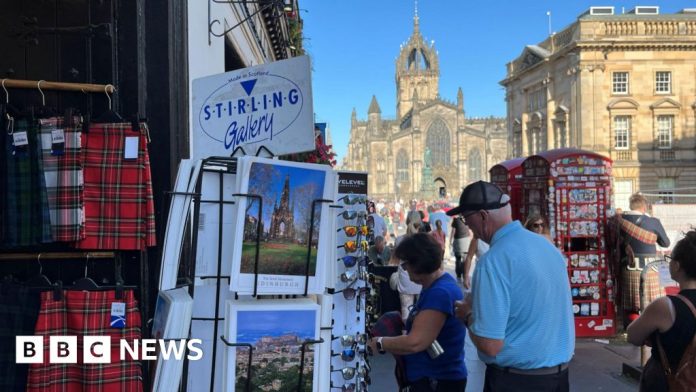Data Journalist, BBC Scotland News
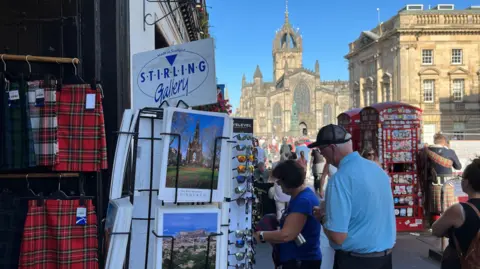 BBC
BBCThe Royal Mile is the ancient spine of Edinburgh, visited by five million tourists each year. The collective name for four streets that thread through the city’s Old Town, it is home to a 900-year-old castle, a palace and a parliament.
But the people who live there claim they are now seeing the overtourism problems being experienced across Europe.
With tourists comes tourist shops, and BBC Scotland News walked the length of the Royal Mile to count up a total of 72 stores, selling everything from kilts to Highland cow fridge magnets.
They are part of an industry that supports more than 40,000 jobs in Edinburgh.
But locals say having so many similar shops in one place is symptomatic of the challenges that mass tourism brings.
The gift shops – most of which are run by three main operators – sell every imaginable Scotland or Edinburgh-themed item, from postcards and soft toys to clothing.
Included are two shops which only sell Christmas-related gifts.
The Royal Mile is also home to 42 cafes or restaurants, 13 bars, eight jewellers and three kilt retailers.
That’s in addition to the museums, cathedral, court, primary school and homes located along the steep and narrow pavements.
‘I’m not against tourism, I just think it has gone too far’

One man who is almost uniquely qualified to understand the impact of tourism on the Royal Mile is 77-year-old Jimmy Robertson.
He has lived on the Canongate, at the bottom of the Royal Mile, since birth and proudly refers to himself as a Canongotian.
Jimmy, who has lived in five different homes, can list the “useful shops” that used to be a stone’s throw away.
They include hairdressers, butchers, grocers and a doctors’ surgery – which is now a whisky shop.
He said it used to be “a normal area” where people would live and work.
“It was probably in the 1980s you saw a lot of people moving out and the street beginning to change,” he explained.
Jimmy used to work at the brewery which is now the site of the Scottish Parliament.
He has long enjoyed sitting outside the 17th Century Canongate Kirk, where one of the benches has an inscription to his late mother.
Jimmy added: “I would sit on that bench and you’d watch the world go by, saying hello to folk you knew coming by.
“Now I sit there and it feels like it is just tourists that pass me by.
“I’m not against tourism, I just think it has gone far in how it affects people who live here.”
Jimmy said he now had to go out of the area to get his food shopping, or rely on relatives to bring it to him.
He said the council was to blame for allowing too many tourist shops to open in one area.
It is a point that some critics argue is borne out by data published by the City of Edinburgh Council last year which shows it owns and rents out 35 shops along the Royal Mile, many of which are leased to tourism businesses.
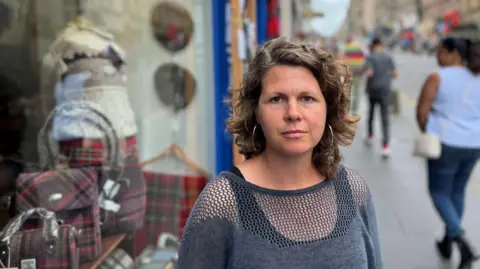
Hanna Wesemann lives just off the Royal Mile and both her children attended Royal Mile Primary School.
In 2004, this Victorian-era built school had 165 pupils but now the roll is down to 118 pupils – well below its 210 capacity.
The 29% fall in pupils does not surprise Hanna, who says the Old Town increasingly “does not feel like a good area to bring up a family”.
Hanna puts this down to the pressures of tourism and the blight of anti-social behaviour by problem drug and alcohol users outside her flat, which requires regular calls to the police.
She said: “It feels like all that’s left here is shops for tourists, tourists, and people who have multiple and complex needs.
“It [the Royal Mile] is on our doorstep but we never go there because there’s nothing for us.
“There used to be some useful shops, even charity shops, but now they are all gone and all I can see is gift shops which all seem to sell the same stuff.”
Increase in international visitors to Edinburgh
Only London beats Edinburgh in terms of the most popular places to visit in the UK.
Domestic visitors account for the bulk of the city’s tourists staying for at least one night – a total of 2.6m in 2023, up from 2.47m in 2015.
But it is overseas visitors who are driving Edinburgh’s increasing popularity.
After a dramatic fall in the Covid years, Edinburgh now attracts one million more international visitors every year than it did a decade ago.
Combined with domestic visitors, that is 4.98m total overnight trips by all visitors in 2023.
Where to accommodate these tourists, especially in peak periods like the Edinburgh festivals, has been a topic of hot discussion in the city for years.
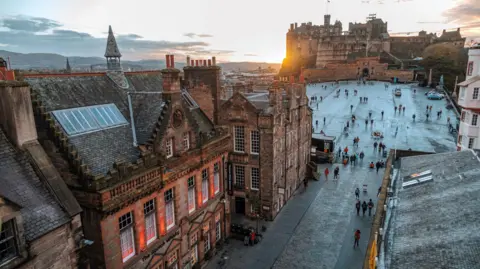 Getty Images
Getty ImagesEdinburgh saw a well documented surge in residential properties being turned over to holiday lets in the previous decade.
The number of listings by Airbnb in the city jumped from 1,900 in 2014 to 9,000 three years later.
New laws requiring operators of short-term lets to have a licence has reduced this tally but data from Inside Airbnb – an independent website which gathers data on Airbnb’s operations – suggests there are still just under 6,000 listings for Edinburgh properties today.
BBC Scotland News counted 96 key boxes of the type typically used for holiday lets on, or just off, the Royal Mile earlier this month.
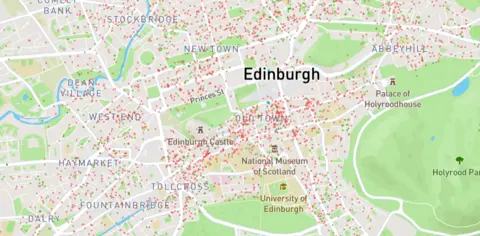 Inside Airbnb
Inside AirbnbThe impact of holiday lets on people living in the most popular tourist areas is very familiar to Hanna and her family.
She explained: “They’re not bad people but they don’t consider this as an area where people live as normal residents.
“You can’t build a relationship with someone for three days and I’m really tired of going upstairs every few days and saying ‘Can you please be quiet, we have to go to work in the morning’.”
While much of the focus on where tourists stay has been on the controversy around holiday lets, there are now 181 hotels in Edinburgh – more than twice as many as there were in 2005.
What tourism does for Edinburgh’s economy
There is little doubt that tourism plays a key role in the city’s economy.
Hosting the world’s largest arts festival every August is a big part of that but tourism is now an all-year round industry.
It is estimated the average overnight visitor spent £435 in 2023.
That filters down to a range of businesses, from coffee shops to taxi firms, supporting thousands of jobs.
A spokesman for the Gold Brothers Group – which owns 16 shops on the Royal Mile and employs 340 people in peak season – said claims about too many tourists were nothing new.
But he added that there was still capacity for more visitors outwith the festivals in August.
The spokesman said: “Our view is that a number of priority issues are being overlooked due to a fixation on tourist numbers.
“The urgent priorities for residents, business owners and visitors to the Old Town are cleanliness as the place is filthy; anti-social behaviour; and criminality including violence and a serious ‘theftdemic’.
“Maybe Edinburgh’s local population could come and visit and reflect on what the Royal Mile looked like years ago with its poorly maintained shops with little or no investment and then, without prejudice, consider the quality of outlets now.”
The spokesman called on the City of Edinburgh Council to “stride to its A game” by cleaning the Old Town more often and ensuring it is “safe and a joy to behold”.
Edinburgh ‘a great place to live and visit’
Council leader Jane Meagher said the local authority was determined ensure the Royal Mile was “clean and well-maintained”.
She also told BBC Scotland News the Old Town High Street was thriving.
Meagher added: “Shopfronts are open, supporting local jobs and our economy, with a great mix of businesses in the area from independent kiltmakers to homemade crafts.
“As one of the biggest landlords in the area we encourage this mix and work to make sure properties are occupied.”
The council leader acknowledged anti-social behaviour remained a concern but said the local authority was working with Police Scotland to address problems.
Additional CCTV has also been installed around the Tron and Hunter Square.
Meagher said: “We’re also making the Royal Mile a safer place for pedestrians and cyclists, while making sure it is clean and well-maintained.
“Our refurbishment of North Bridge is a visible commitment of our plans to ensure the area remains at the beating heart of the city, as is the extra £1m we’re investing this year to tackle litter and graffiti in our communities.”
The funding includes additional resources for washing pavements and closes in the Old Town.
Meagher said: “Once Edinburgh’s visitor levy has launched, we hope to invest even more money to manage the impact tourism has, to ensure our city remains a great place to live and to visit.”
The future of tourism in Edinburgh
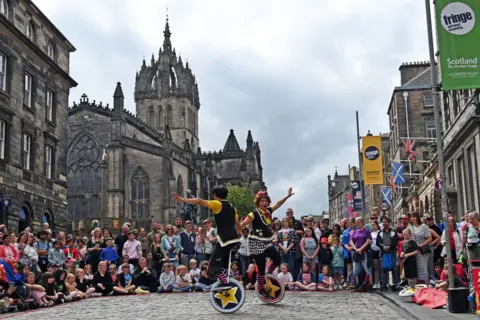 Getty Images
Getty ImagesThe latest Scottish census suggests just under 9,000 people live in the areas in and around the Royal Mile.
This covers the tall blocks of flats that flank either side of the Royal Mile and the nearby council-built estate of Dumbiedykes, which has about 600 homes but no shop, GP surgery, pharmacy or post office.
All of these residents feel the direct pressure tourism can bring but there are wider pressures on the city too.
A 8.4% jump in the city’s population in the 10 years to 2023 has contributed to a deepening housing and homelessness crisis.
Next year Edinburgh will introduce the kind of tourist tax that is common around Europe and city leaders have pledged to invest the £50m it is expected to raise every year on infrastructure improvements.
This has been mostly welcomed but some fear it might not be enough to help Edinburgh adapt to the growing demands of tourism.

